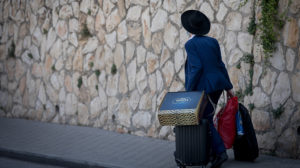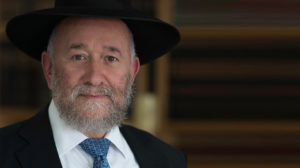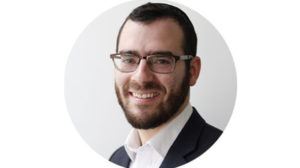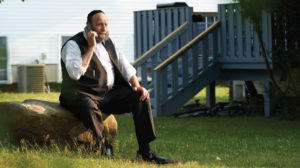Keep It Sweet

For veteran educator Rabbi Nachman Zakon, every parent is a teacher
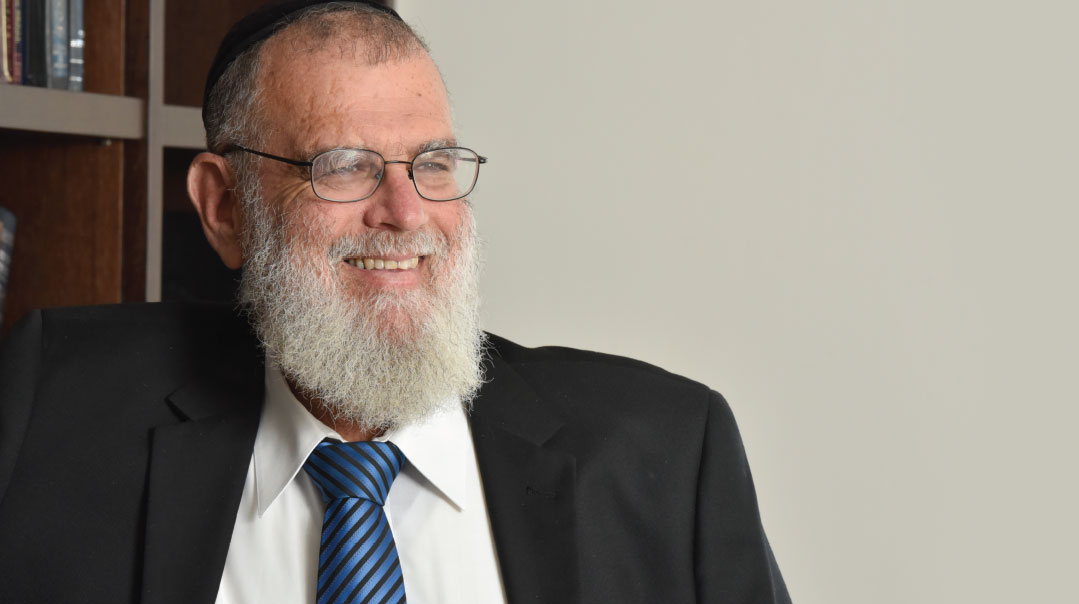
(Photos: Pinchas Emanuel)
During his first year as a teacher, Rabbi Nachman Zakon realized something was seriously wrong.
Back then Rabbi Zakon, who currently serves as the director of Yeshiva Teachers Institute in Yerushalayim, was teaching in an out-of-town day school. He had a student who was giving him considerable problems in classroom management. Rabbi Zakon met with the school principal to determine a course of action.
The principal dropped a bombshell: Sammy had a Jewish mother but a non-Jewish father. The Jewish mother had passed away, but she had extracted a deathbed promise from her non-Jewish husband that the child would receive a Jewish day school education. The father had since remarried a non-Jewish woman, and now Sammy, this halachically Jewish child, was being raised in a home with an Xmas tree. There was basically nothing the school — or anyone — could do for him.
“Sammy gave me my first gray hair,” says Rabbi Zakon.
As he reflected on this dilemma afterward, Rabbi Zakon realized he had been dropped into his role without any tools or training for dealing with such a situation, and for teaching in general. Eventually he resolved to use the experience as an impetus to develop training programs for teachers in both in-town and out-of-town schools, so that others would be equipped to face the complexities inherent in the field.
Rabbi Zakon has broad experience in chinuch: He has taught children, post–high school students, and senior citizens; in town and out of town; in America and in Eretz Yisrael; in kiruv programs and mentoring programs.
A product of Torah Vodaath in New York and Ner Israel in Baltimore, Rabbi Zakon and his family moved to Eretz Yisrael more than 30 years ago.
“My grandfather lived in a Polish shtetl in the 1930s and decided that the ground was burning beneath his feet,” Rabbi Zakon says. “He wanted to move to Eretz Yisrael, but his father asked him, ‘Are you going kosher or treif [legally or illegally]?’ During the British Mandate period, there was no ‘kosher’ way to enter Eretz Yisrael, so at age 20, he moved to Brazil instead.” At age 70, he finally made aliyah. “So the desire to live in Eretz Yisrael is in my genes.”
The Zakons started out out in Zichron Yaakov, a seaside town between Haifa and Hadera, where Rabbi Zakon entered the town’s English-speaking kollel. There he met Rav Nachman Bulman ztz”l, who came to speak at the kollel — and gained a new talmid.
“After hearing him, I came home to my wife and announced, ‘We’ve found our rav,’ ” he says.
Though he had trained as a chemical engineer, after meeting with Rav Bulman and being inspired by his dedication to teaching Torah, Rabbi Zakon decided that the Jewish People need Torah teachers more than they need another engineer. And he’s never looked back.
The Zakons eventually moved to the Har Nof neighborhood in Jerusalem, where they still live today. It was a heavily Anglo neighborhood from the start. Rabbi Zakon started out teaching in the local Israeli cheder system, and discovered that the needs and sensitivities of Anglo kids were going unmet. Together with the current Bostoner Rebbe of Har Nof, Rav Mayer Alter Horowitz shlita, Rabbi Zakon founded the first cheder for English-speaking families in Jerusalem. It was a model that has been successfully duplicated.
“Now many other such schools are providing an American approach to chinuch,” he says.
Rabbi Zakon can point to many moments over the course of his career when he had the clear feeling this is why I do what I do. He derives great personal satisfaction whenever he hears that a teacher he has trained has become the menahel of a school, because it means that his chinuch methods are being implemented on a schoolwide basis. One graduate of his teacher training went on to make educational films for teaching middos to American yeshivah students. Rabbi Zakon was once in a pizza shop when another teacher he trained walked in with his own class of bochurim and bought them pizza. “He was sitting and schmoozing with them, building relationships — this is what the training was all about.”
Long after the Details
With the publication of The Weekly Parashah, Rabbi Zakon has found a new source of satisfaction. “You can reach so many more people through a book than you can in many years of teaching,” he says. In the book, he has made good use of his decades of experience in chinuch. “I used every chinuch trick and technique that I knew to get the kids’ attention — and keep it.
“A lot of what I’ve learned about teaching comes from talking to students of mine whom I met years later, when they were adults,” he observes. “They remember what you did for them long after they’ve forgotten the details of what they learned from you.”
As a cheder rebbe, at Purim time, Rabbi Zakon bought stalks of raw sugarcane at a local Spanish bodega. The talmidim who brought him shalach manos would each receive a sample, along with special instructions. “I called it ‘Rebbi’s magic stick,’ ” he laughs. “I told each student to bite into it. If it tastes sweet, then he’ll know he’s going to grow up to become a tzaddik.”
The power of this experiential technique was enduring. “I would meet those students years later, when they were themselves parents,” Rabbi Zakon says, “and they always told me, ‘I remember Rebbi’s magic sticks!’ ”
Today’s children, he says, face a host of new and different challenges. His conversations with children themselves, as well as their teachers and parents, has given him a clear perspective on how they view the world.
Interestingly, he says the frum world’s modern abundance — not just in material wealth, but also in the dramatic growth of Torah learning — presents a particular hurdle.
“Today’s kids are in awe of their parents’ success — and insecure about their own future,” he says. “They’re also intimidated — by high academic standards, high standards for life roles, by high expectations for frum life… That insecurity creates a crack through which the outside world enters, with all its enticements. As they get older, they get more insecure.”
The cost, Rabbi Zakon says, is measured in the number of children going off the derech. “If they’re lucky, they’ll have an encounter later on with a post–high school yeshivah that finally gives them that security and the inspiration that they need.”
Rabbi Zakon once spoke to his neighbor, Rabbi Dovid Orlofsky, about how different the world today is from the one facing the postwar generation, the one that they had grown up in. A world rebuilding from the devastation placed high premiums on reaching and retaining every Jewish neshamah.
“It used to be that every kid was wanted in yeshivah,” Rabbi Orlofsky said. “We in the post-Holocaust generation knew we were special. There weren’t so many of us.” With today’s classrooms filled to bursting, kein ayin hara, that focus has receded.
“That message is not getting through to our kids today,” Rabbi Zakon laments. “They don’t feel how special it is being Jewish. And they don’t feel how special they are to us.”
Of course, aside from the challenges hidden within blessings, there are also outright challenges to deal with: More kids are coming from homes of divorce, blended families, and homes where there is chronic illness. And so many are coming with ADD, ADHD, and learning disabilities. There has also been a dramatic decline in the amount of quality time between parents and children, as children compete with Mommy’s and Tatty’s phones and WhatsApp chats.
But just complaining about today’s students and their challenges is emphasizing the wrong question.
“There is no purpose in discussing how children have changed over the last few decades,” Rabbi Zakon declares. “We have to accept them for who they are, in order to deal with the challenges of educating them. We can talk about issues in their environment, though.”
Rabbi Zakon describes an incident he observed when he was teaching in an Israeli chareidi yeshivah ketanah. He had managed to build up a level of trust with the bochurim that was strong enough that they wanted to share their lives and interests with him. A bochur had gotten an MP3 for his birthday — back in the halcyon days a few years ago when such a device was considered a big deal — and he was so proud of it that he showed it to Rabbi Zakon. It had already been loaded with 500 non-Jewish songs.
“I was shocked and advised him that the hanhalah would not be happy with him if they discovered he was in possession of this item,” Rabbi Zakon recounts. “He assured me it was fine, because ‘it also had Jewish songs on it.’ The main point here is the sheer quantity of garbage that’s accessible in seconds. It’s causing an enormous challenge in chinuch today. This bochur, a good boy, had the MP3 for only one day and look what he could already listen to.”
Although the challenges facing this generation are unique, Rabbi Zakon says that Jewish educators have a well-stocked arsenal of ready-made, timeless techniques for resolving them. Rabbi Zakon employs one of these tips frequently in his writing and speaking.
“When talking about G-d with your children, find opportunities to point out Hashem’s power,” he advises. “Try always to link Hashem to some kind of description, like powerful or merciful, or refer to His Guiding Hand. Children don’t begin to form the ability for abstract thought until later. Referring to Hashem this way will help make G-d more concrete to them.”
Pick Your Battles
As director of the Yeshiva Teachers Institute, a chinuch training program for kollel men, Rabbi Zakon is able to impart important principles to this generation’s up-and-coming mechanchim.
“Try to reach every kid — no kid should be left out,” he says. “Acknowledge different intelligences. Respect and praise kids who are good in music and sports. Kids learn in different ways — in my program, I teach my students to discover if the children in their class learn better through audio methods, visual methods, or kinesthetic methods. Rebbeim should be sensitive to that.”
He recounts an incident from his time as the principal of a cheder: A child who had acquired a reputation for acting out was accused by his rebbi of a transgression. This time, the child vigorously protested his innocence. The rebbi sent him to Rabbi Zakon’s office.
“I listened to him, gave him a piece of candy, and sent him back to class,” Rabbi Zakon recalls. “A few years later, a psychologist who was working with this child asked him for one memory he had of school. This child remembered getting that piece of candy — because somebody believed him. That gave the psychologist a building block to work with.”
Rabbi Zakon has implemented extensive training programs for teachers over the years, but he has also developed valuable guidance for cooperation between teachers and parents. After all, they share the same ultimate goal: The child/student should identify strongly with the values and ideals of the family/school. Part of the guidance involves delineating the important roles that both teachers and parents play in their partnership.
As background, Rabbi Zakon shares the advice he received in his consultation with noted chinuch expert Rav Noach Orlowek, mashgiach at Yeshivas Torah Ore in Jerusalem. Rav Orlowek related a statement made by Rav Yitzchok Hutner ztz”l years ago at a Torah Umesorah convention: “A rebbi iz a bimkom tatte [A rebbi is a stand-in for a father].” (Rabbi Zakon amends that to include “A morah iz a bimkom ima.”) Rav Orlowek further passed along something in the same vein he heard from his own rebbi, Rav Simcha Wasserman ztz”l: In order for a rebbi to have a talmid, he must adopt him.
With that in place, Rabbi Zakon drills down into greater detail. At the elementary school level, Rabbi Zakon says, children are in a formative stage, so teachers and parents both play very active roles. Teachers should be instilling a love of learning in their students, and imparting the important skills children will need for learning on their own. An elementary school teacher should make sure that each child in the class is further along at the end of the year than at the start. Parents at this stage should be providing a safe, loving home environment where children can absorb the middos they see being modeled. Parents should also be discovering each child’s strengths and playing to them; if the child has interests in art or music, those should be encouraged. If a child is an academic underachiever, then grades and test scores should be underemphasized.
At the high school level, Rabbi Zakon advises both parties to step back. Teachers should be inspiring their students to be good Jews and transmitting hashkafos in a positive, exciting way. Parents should recognize that the window has closed for management of children’s behavior and forcing them to do the parents’ will. Parents at this stage, he says, “have to be salesmen, marketing Torah and Yiddishkeit.” Persuasion and patience will win out over confrontation. When confrontation becomes necessary, parents should pick their battles very carefully.
Dream or Nightmare?
Rabbi Zakon offers parents perspective on whom teachers see as “dream” parents — and the ones who cause nightmares.
Dream parents, he said, show active interest in what their children are learning.
“Not testing them on the material, just showing interest,” he emphasizes. As an example, he relates that during a period when his own grown children were very busy and he was watching his grandchildren, he would ask them, when they walked in the door from school, “What’s in your backpack? What books are you using?”
“Dream parents” also work cooperatively. When there’s a problem, they work together with the teacher to resolve it. When there’s a school project for the child that requires parental participation — say, for brachos or Mishnayos — they pitch in. Any parent who calls the teacher to express gratitude is a “dream parent,” says Rabbi Zakon. He illustrates another type with an example from his own teaching career.
“I had a parent once who was a principal himself,” he says. “He would take my ideas and pass them along to his teachers to use. I would send home postcards to parents with colorful graphics and praises of their children; this principal showed these to his teachers and told them to start using them. He was a dream parent.”
On the other side of the ledger are the parents who cause teachers to have nightmares. Rabbi Zakon here includes parents who call the teacher to try to set his curriculum for him, advising him on what material to cover and at what pace. Some parents also use chance encounters at shul or at the store as an opportunity for an impromptu PTA meeting to discuss a problem. Rabbi Zakon says such parents should show higher regard for the teacher’s professionalism. “Would you have a meeting with your accountant in such a setting?” he asks.
Parents who speak negatively about a teacher in front of their children are causing serious damage, he says. He recalls an incident he heard about in a frum school in the higher grades, where a student stood up in front of a class and told the teacher, “My father is a rosh yeshivah and he says you’re an am ha’aretz.”
Rabbi Zakon says some first-time parents can be overly ambitious, if they are the type who want their child to be assured admittance into the best school, yeshivah, or university.
“These parents have invested all their dreams in this first child, and when he falls short, they are looking for someone to blame,” he says. “Usually by the second or third child, parental expectations have realigned to be more realistic.”
The Goal Is to Love Torah
As important as the school environment is, though, Rabbi Zakon says parents have an even more critical role to play in their children’s chinuch. And Jewish tradition provides them a tailor-made stage for presenting the colorful tableau of the mesorah: the Shabbos table. Rabbi Zakon offers a basic rule for centering the table around discussion of the weekly parshah — and avoiding missteps.
“Parents should conduct the Shabbos table in such a way that the children remember it positively,” he says.
Calibrating the table talk this way requires an understanding of each child’s needs and abilities, Rabbi Zakon says. Parents need to accurately take stock of where their kids are holding.
“What is the goal? To give them a chance to show off what they learned this week?” he asks. “No. The Shabbos table is not for testing them on what they heard in class. Maybe for the ones who excel in school, this might be a fun experience — but it’s certainly not for the ones who don’t excel.”
It also means making the conversation a showcase for Hashem’s works. This is important not just in terms of safeguarding a child’s self-esteem, but also in terms of opening a channel for Divine connection.
“The Shabbos table should be for telling the children about the parshah,” Rabbi Zakon says. “The parshah teaches us about Hashem. This is G-d’s word. Very often, especially for boys in the older grades, children can go through the whole week without hearing about G-d. The parshah is a platform for making G-d real to their lives.”
Rabbi Zakon offers concrete suggestions for parents to engage their children through the parshah. One way is to frame hypothetical situations based on the events described.
“Use the word ‘imagine,’ ” he says, “as in, ‘Imagine you were at Har Sinai.’ ”
His new book illustrates this technique with an example from parshas Bereishis, tracing the root of the conflict between Kayin and Hevel:
Kayin decided to bring a korban (offering) to Hashem to thank Him for the food he grew. That was a good idea. But instead of bringing his best fruits as a korban, he chose the poorest-quality ones. That was bad.
Imagine a family gets a box of mishloach manos on Purim. They take out all the fancy chocolates and yummy candies to keep for themselves. What’s left in the box? Some dried-up raisins, black jelly beans, and packages of stale popcorn that no one wanted. Then they go and send these leftovers as mishloach manos to their best friends. That is not nice!
That is a lot like what Kayin did. That is what he gave to Hashem.
Another way to engage the little ones’ minds is by asking questions. “The parshah contains all the tools children need for getting along in school, in life,” says Rabbi Zakon. “For example, in teaching about Migdal Bavel: Why did Hashem treat the people in the Dor Haflagah so much more leniently than the Dor Hamabul? Because they got along. You can engage your children with questions on this. Does everyone in your class get along?”
Of course, parents leading such a discussion should ideally themselves have a well-formed relationship with Hashem.
“You have to be excited about talking about it — you can’t say it deadpan,” Rabbi Zakon stresses. “The goal of parents at the Shabbos table is love of Torah, love of Shabbos, using the weekly parshah to inculcate love of Hashem. Build a relationship with Hashem — you should love Him. After all, He loves you.”
On the other hand, Rabbi Zakon cautions against taking too didactic an approach. “The Shabbos table is not a classroom. It should be relaxed. It doesn’t even have to be at the table. You can move the discussion to the couch. The Shabbos table also shouldn’t be a jail. If a child wants to leave, let him leave. We have to treat children as they really are, not as we want them to be.”
If the Shabbos table is conducted properly, Rabbi Zakon says, it should lead to spiritual growth for everyone in the household. If it instead leads to conflict, it means you should be changing the way your Shabbos table is run.
“If the Shabbos table is a flashpoint, as it often is, find out what’s wrong,” he counsels. “You shouldn’t be having the same fights every week about the same thing. There are probably deeper underlying issues that need to be dealt with. The Shabbos table is not the place for that.”
Today’s Child as He Is In addition to directing the Yeshiva Teachers Institute, Rabbi Zakon has been busy writing material for children for the last ten years. His published titles include Treasure from Sinai and 2,000 Years of Jewish Experience.
The latter book was at the center of an amusing incident Rabbi Zakon experienced in a bookstore.
“I saw some bochurim looking at the history section,” he recounts. “I pointed out my book [2,000 Years of Jewish Experience] and told them this is a good overview of history. One of the bochurim said, ‘We have that book in my house — it’s a great book.’
“I said, ‘I’m very happy to hear you say that — I’m the author.’
“He said, ‘You’re sketching me!’ ” [Rabbi Zakon helpfully translates this as “You’re kidding me” for the more-out-of-touch.]
“I ended up having to show him my driver’s license.”
Last year, he coauthored The Story of Rebbetzin Henny Machlis with his wife, Mrs. Miriam Zakon. The book presented children the life story of the well-known Maalot Dafna homemaker who, together with her husband, while raising their many children, transformed their home into a nonstop chesed operation until she was niftar at a tragically young age.
Rabbi Zakon also became a favorite of Mishpacha Jr. readers for his “Zooming Around with Zeidy Zakon” column, which featured a written guided tour of various important religious and historic sites around Eretz Yisrael.
For Rabbi Zakon, it’s all part of a seamless whole — a life’s mission dedicated to instilling in Hashem’s People a love for Him.
“We want to deal with today’s child as he is,” he says. “He needs a strong, positive connection to Torah, and a strong relationship with Hashem. I want all Jewish children to have a connection to Hashem and His Torah.” —
Making the Chumash Come Alive
“The Weekly Parashah is about reaching the child on his level, at his ability to read and understand,” Rabbi Zakon says. “Telling the story of the parshah with the midrashim, combined with the commentaries, makes it come alive, makes it real. The sidebars are perfect for today’s generation, with their shortened attention spans, and the text is even broken up into bite-size pieces.”
Sefer Bereishis, the first volume of The Weekly Parashah, is already out, and the second volume, Sefer Shemos, will be published in time for parshas Shemos.
The volume is lavishly illustrated, and the design uses elements to grab and hold a young reader’s attention. The text is presented in a pleasing, easy-to-read typeface, and sidebars supply interesting nuggets of information, along with thought-provoking questions. One of the most important sidebars, Torah in Our Lives, connects the lessons of Chumash with the children’s world.
The book is richly sourced, making it an invaluable tool for parents and educators — but there are no footnotes to draw the eye to the bottom of the page, away from the thread. Instead, readers seeking citations can flip to the endnote section in the back.
All the design decisions — eye-catching graphics, colorful illustrations, short blocks of text that do not overwhelm — were deliberate. Although some might think the approach is a surrender to short attention spans, Rabbi Zakon says it takes the battle straight to the yetzer hara’s central strategy. “Because we live in a world of graphics and images, we needed a book that would be graphically beautiful.”
The ArtScroll connection also gave Rabbi Zakon a chance to revisit another meaningful chinuch encounter. “Rabbi Nosson Scherman [ArtScroll’s general editor], who contributed to the parshah book, was my fifth- and sixth-grade rebbi. Once, when he was my rebbi, he caught me reading a book on evolution. The usual response at that time to that sort of thing would have been to yell and scream. But he did no such thing. He took me for a long walk, and we talked. And I never looked into such a book again. So it was really coming full circle to work with him on this project.”
(Originally featured in Mishpacha, Issue 782)
Oops! We could not locate your form.



